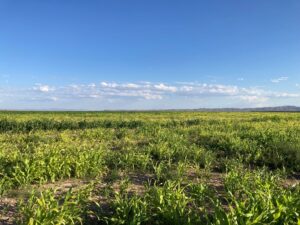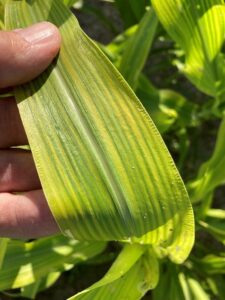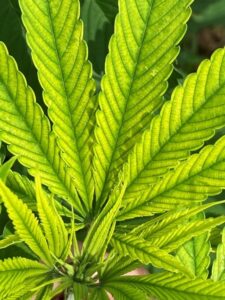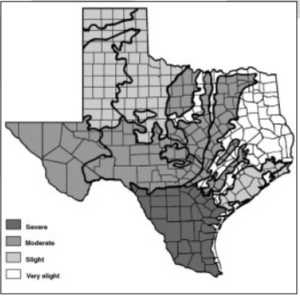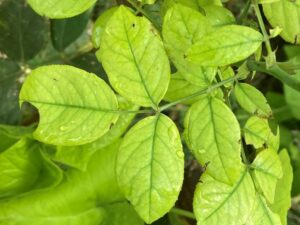Distinct iron chlorosis in plant leaves makes diagnosis easier
Dr. Calvin Trostle, Extension Agronomy/TAMU Dept. of Soil & Crop Sciences, Lubbock, (806) 746-6101, ctrostle@ag.tamu.edu
December 2023
Culberson Co. ag. agent Zach Schaefer and I visited this sorghum/sudan field in early September (Fig. 1). From the road it was evident much of this field was heavily iron deficient. This issue is most common in Texas sorghums, both grain and forages, as all sorghums have poor iron uptake efficiency relative to other crops.
Fig. 1. Yellow plants across a portion of this sorghum/sudan field in Culberson Co. indicate severe iron chlorosis (deficiency) that is greatly restricting plant growth. In the far background the field is green and growing normally.
Classic Iron Deficiency Symptoms in Plants—Interveinal Chlorosis
Iron deficiency in plants is among the easiest of symptoms to identify. This is classic “interveinal chlorosis,” or chlorosis (yellow) between the leaf veins, which remain green (Fig. 2). Also, iron is immobile within the plant. Thus, symptoms first appear on the youngest leaves. In the most severe cases the leaves can become bleached out to a pale color where even the veins are no longer green.
Fig. 2. Iron deficiency in Texas crops. Left, sorghum/sudan, Hudspeth Co.; Center, peanuts, Lamb Co.; Right, Cannabis sativa (industrial hemp), Lubbock Co. Sorghum/sudan and hemp demonstrate common interveinal chlorosis with yellow leaf tissue between green veins. Severe iron deficiency in peanut has bleached the leaves in part due to major rainfall, flooding, and poor soil drainage which compounds iron deficiency (but alleviated by drying conditions and expanding root volume).
The Role of Iron in Plant Nutrition
Iron is an essential element for plant nutrition. Iron is necessary for production of chlorophyll which is the plant pigment that gives their green color and traps the light necessary for photosynthesis. Other iron roles include numerous enzyme systems. When iron is limiting plants may be stunted. Under severe iron deficiency plants can die.
Factors of Iron Deficiency
- There is a wide variation among different plant species in plant root solubilization of iron, iron uptake, and internal translocation of iron among plant species. The sorghums are among the worst. Corn (maize) grown on the same ground as iron-deficient grain sorghum usually is OK. Hybrid pearl millet is sometimes a sensible substitute for sorghum forages as it has a different, more efficient root iron uptake mechanism.
- Soil iron is difficultly available with increasing soil pH above 7. Caliche (geologic calcium carbonates) and alkaline soils are prone to cause iron deficiency, especially in sensitive crops like the sorghums. Essentially all crop plants are subject to iron deficiency if conditions are favorable. High pH soil conditions exist especially in South Texas, then the Texas Blacklands (like the Houston Black clay), far west Texas, and the High Plains (Fig. 3).
- In addition to high pH, heavy rains and poorly drained (water-logged) soils can also induce intermittent iron deficiency. Once dry conditions return and the soil drains and dries then adequate iron uptake resumes.
Fig. 3. Texas soil resources and tendency to produce iron deficient conditions for plant growth. (Range is dark, or severe to light, or very slight. (From SCSC-PU-088.)
Correcting Iron Deficiency in Plants
AgriLife Extension most often responds to questions about iron deficiency in an existing crop rather than a longer-term consideration of soils that are iron deficient. For most field crops it is difficult and inadvisable to treat the soil as the applied iron, even in chelate form (to maintain availability), is difficultly available—and too expensive. Adjusting soil pH down from high pH is likely not feasible just to increase iron availability.
The quickest means to address iron deficiency in an existing crop is a foliar spray. The choice of product, usually a chelate but also ferrous (the more soluble form of iron, Fe2+) sulfate, may depend on availability. This is a temporary fix in some cases. The immediate concern is to supply the crop with enough iron to abate acute iron deficiency to enable continued growth and development. More than one spray might be needed. Sometimes iron deficiency may appear in a young crop but as the root volume expands iron deficiency is alleviated.
For longer-term solutions to iron deficiency, a farmer may submit a soil sample for soil testing to include micronutrients. Then follow soil test lab advice for remediation if soil iron is deemed low. Crop consultants in the Texas High Plains also report that cattle manure, if available, will help improve iron availability for sensitive crops. More information on treating iron deficiency is noted below in “Further Information.”
Iron Deficiency in the Home Landscape and Garden
Among a wide variety of landscape and garden plants some will encounter iron deficiency. Symptoms are similar to field crops (rose from the Trostle home, Fig. 4). Like field crops, the plant response will depend on its susceptibility to low iron. There are two common means for treating iron deficiency in plants at home. First, for immediate iron deficiency consider a foliar spray that contains an iron chelate (and often other micronutrients like zinc, copper, and manganese). This could be either a pre-mix in a ready-to-use pump spray, or a liquid concentrate that you dilute then spray. For iron-deficient soils you can purchase iron chelate in solid form to either mix in your soil or create a drench to water the chelate in.
If soil pH is high (especially if over ~7.5 you can thoroughly mix elemental sulfur (S) into your soil at about 1 lb. per 100 square feet to about 6 inches deep. (For potted soils this is about 10 grams of elemental S per 1 cubic foot.)
Texas A&M AgriLife Extension horticulture agents can provide further information correction of home landscape and garden iron deficiency.
Fig. 4. Iron deficiency in ‘Mr. Lincoln’ rose. (Calvin Trostle).
Further Information on Iron Deficiency and Correction
- “Iron (Fe) Deficiency in Texas Crops Made Worse by Wet Weather,” https://lubbock.tamu.edu/files/2023/09/Iron-Deficiency-in-Texas-Crops-2023.pdf
- “Correcting Iron Deficiencies in Grain Sorghum,” SCSC-PU-088 (originally 1996), access through http://AgriLifeLearn.tamu.edu
Texas A&M AgriLife Extension/Department of Horticulture, “Iron Deficiency,” https://aggie-horticulture.tamu.edu/vegetable/problem-solvers/cucurbit-problem-solver/leaf-disorders/iron-deficiency/
